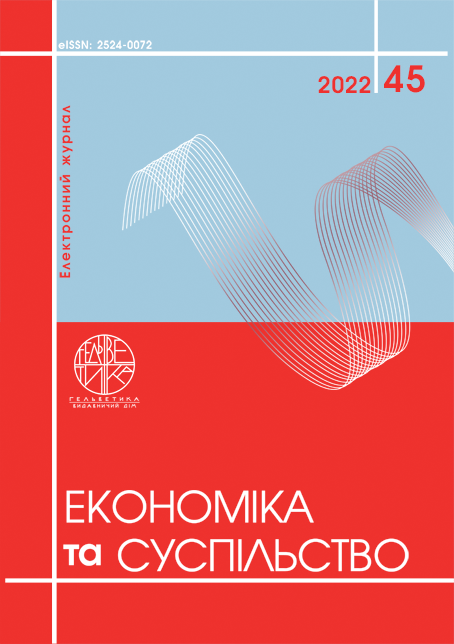WAYS TO REDUCE THE RISKS OF MILITARY ECOCIDE THROUGH RECYCLING OF CONSTRUCTION WASTE IN REAL ESTATE DEVELOPMENT
Abstract
The article is devoted to the study of ways to minimize the risks of the impact of construction waste on the environment during the elimination of the consequences of armed aggression. Demolition wastes have a destructive effect on the natural environment: they poison the soil, water resources and the atmosphere, pollute the environment, and intensify the negative trends of climate change. Since the military ecocide in Ukraine led to the damage of a significant number of real estate objects, the consequences of the large-scale destruction of buildings and infrastructure facilities took on the characteristics of an ecological disaster. It is noted that, without appropriate processing, a significant amount of construction waste can multiply the area of their burial. Currently, it is difficult to obtain accurate and detailed data on the current number of destroyed and damaged real estate objects during the Russian-Ukrainian war. Citizens, state and local authorities do not have the opportunity to record the damage caused in certain cities and settlements in a timely manner (the estimated amount is provided late using indirect methods of assessing the value of destroyed real estate). Information about the destruction becomes reliable after the end of hostilities in the respective regions of Ukraine. To solve this problem, the teams of the Office of the President, the Ministry of Economy and the Kyiv School of Economics Institute (KSE Institute) created the "Russia will pay" project, which focuses on the physical assessment of losses due to the war (residential buildings; communal, road and railway infrastructure; educational and medical institutions etc.), as well as on the approximate financial assessment of the losses incurred by Ukraine. Roughly, the construction industry can consume up to half of what is produced by mankind. One of the oldest industries in the history of material production produces up to a third of all waste in the European Union. Increasing the cyclical use of construction waste will allow to increase its reuse up to 80%. The intensity of hostilities and the massive use of heavy weapons negatively affected the state of the environment in Ukrainian cities and towns. The amount of construction waste from completely destroyed buildings worsens environmental problems accumulated over decades. One of the directions for reducing the risks of ecocide is the development of design requirements for the administration of the construction waste management system by local self-government bodies, which will allow stopping the processes of chaos during the dismantling and liquidation of construction waste.
References
Щуваєв А.А. Інструментарій залучення відходів будівництва та зносу до повторного господарського циклу в контексті класифікаційних ознак. International scientific journal «Grail of Science». 2021. №10. 2021. DOI: https://doi.org/10.36074/grail-of-science.19.11.2021.114
Арутюнян А.І., Шуваєв А.А. Екологічно-економічна доцільність комплексного управління потоками відходів в будівельній галузі. Мости та тунелі: теорія, дослідження, практика. 2020. № 18. С. 9–17.
Шпакова Г.В. Формування економіко-управлінських предикторів девелопменту на інноваційній платформі рециклінгу будівельних відходів. Ефективна економіка. 2020. № 1. URL: http://www.economy.nayka.com.ua/?op=1&z=7609 DOI: 10.32702/2307-2105-2020.1.91
Міністерство розвитку громад та територій України. Звітність «Санітарна очистка» за 2020 рік. URL: https://www.minregion.gov.ua/wp-content/uploads/2021/06/rozdil-4-2020_oblasti.pdf
Затверджено національну стратегію управління відходами в Україні URL: https://dlf.ua/ua/zatverdzheno-natsionalnu-strategiyu-upravlinnya-vidhodami-v-ukrayini-do-2030-roku-2/
Про схвалення Національної стратегії управління відходами в України до 2030 року. Офіційний вебпортал парламенту України. URL: https://zakon.rada.gov.ua/laws/show/820-2017-р#Text
Екологія Право Людина. URL: http://epl.org.ua/wp-content/uploads/2019/09/Ramkova-dyrektyva-presreliz.pdf
Кондращенко, Е.В., Качура, А.А. О проблеме городов по использованию строительных отходов от сноса зданий и сооружений. Комунальне господарство міст. 2012. № 107. С. 150–155.
RussiaPay. URL: https://damaged.in.ua/
Прямі збитки, нанесені інфраструктурі України в ході війни, складають майже $63 млрд. Загальні втрати економіки $543-600 млрд. Kyiv School of Economics. URL: https://kse.ua/ua/about-the-school/news/zbitki-naneseni-infrastrukturi-ukrayini-v-hodi-viyni-skladayut-mayzhe-63-mlrd/
Shchuvaiev A.A. (2021). Instrumentarii zaluchennia vidkhodiv budivnytstva ta znosu do povtornoho hospodarskoho tsyklu v konteksti klasyfikatsiinykh oznak. International scientific journal «Grail of Science». № 10. DOI: https://doi.org/10.36074/grail-of-science.19.11.2021.114
Arutiunian A.I., Shuvaiev A.A. (2020). Ekolohichno-ekonomichna dotsilnist kompleksnoho upravlinnia potokamy vidkhodiv v budivelnii haluzi. Mosty ta tuneli: teoriia, doslidzhennia, praktyka. № 18. S. 9–17.
Shpakova H.V. (2020). Formuvannia ekonomiko-upravlinskykh predyktoriv developmentu na innovatsiinii platformi retsyklinhu budivelnykh vidkhodiv. Efektyvna ekonomika. № 1. Available at: http://www.economy.nayka.com.ua/?op=1&z=7609 DOI: 10.32702/2307-2105-2020.1.91
Ministerstvo rozvytku hromad ta terytorii Ukrainy. Zvitnist "Sanitarna ochystka" za 2020 rik. Available at: https://www.minregion.gov.ua/wp-content/uploads/2021/06/rozdil-4-2020_oblasti.pdf
Zatverdzheno natsionalnu stratehiiu upravlinnia vidkhodamy v Ukraini. Available at: https://dlf.ua/ua/zatverdzheno-natsionalnu-strategiyu-upravlinnya-vidhodami-v-ukrayini-do-2030-roku-2/
Pro skhvalennia Natsionalnoi stratehii upravlinnia vidkhodamy v Ukrainy do 2030 roku. Ofitsiinyi vebportal parlamentu Ukrainy. Available at: https://zakon.rada.gov.ua/laws/show/820-2017-r#Text
Ekolohiia Pravo Liudyna. Available at: http://epl.org.ua/wp-content/uploads/2019/09/Ramkova-dyrektyva-presreliz.pdf
Kondrashchenko, E.V., Kachura, A.A. (2012). O probleme horodov po yspolzovanyiu stroytelnыkh otkhodov ot snosa zdanyi y sooruzhenyi. Komunalne hospodarstvo mist. № 107. S. 150–155.
RussiaPay. Available at: https://damaged.in.ua/
Priami zbytky, naneseni infrastrukturi Ukrainy v khodi viiny, skladaiut maizhe $63 mlrd. Zahalni vtraty ekonomiky $543-600 mlrd. Kyiv School of Economics. Available at: https://kse.ua/ua/about-the-school/news/zbitki-naneseni-infrastrukturi-ukrayini-v-hodi-viyni-skladayut-mayzhe-63-mlrd/


